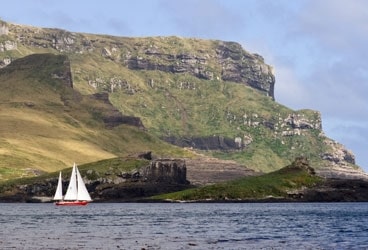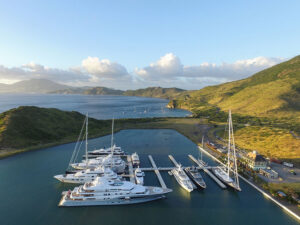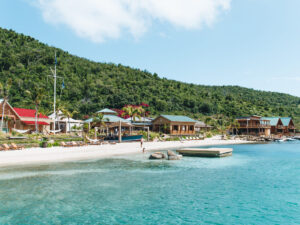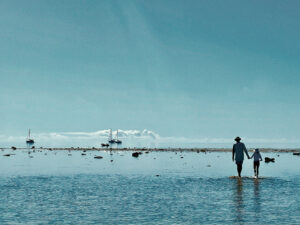
Auckland 368
At 50 degrees south, during the height of summer, nighttime is only five hours long. Even then, it’s rarely dark. Last night, with rose-colored aurora australis undulating across the southern sky like curtains at an open window, I could work on deck without artificial light. Tonight, an extraordinary abundance of bioluminescence in the water lights the scene. Multitudes of wave crests glow greenish-white-like neon light, I think-as a sudden movement in my peripheral vision makes me look astern. Dozens of skinny green lines are closing in on Northern Light. As they near, I see the bodies of the fish. So can dolphins, who zoom in to feed. The school scatters, the fish flashing away, pursued by what looks like long-tailed comets.
During our 350-mile passage from Macquarie Island, the wind never goes above 35 knots. After two pleasant days at sea, we sight Adams Island, the southernmost island in the Auckland Island group. A nesting area for endangered albatross, Adams is off-limits to tourists, so we continue past it to the east side of Auckland Island-the coastline is deeply indented with fjords-and Waterfall Inlet, a keyhole-shaped bay with a narrow entrance. Wind diminishes to nothing as we enter. The perfect anchorage.
We’re pleasantly stunned. The only picture we’d seen of rata trees led us to expect their flowers to be dull brown. But the clusters of trees rimming the inlet are decked out in bright crimson! The next shock isn’t as positive. The bull Hooker’s sea lion who’s claimed Waterfall Inlet is so contrary that he must’ve been ousted from a breeding colony and come here to establish his own territory. He swims out, charging and growling at Northern Light. His cows and pups remain on the beach. Aloud, I wonder how he’ll react when we go ashore. Rolf suggests we wait. “Maybe the harem will have moved on by tomorrow,” he says.
It doesn’t. As we pull the dinghy up the stony beach, the bull pops up in the shallows, snapping and snorting. Worried that he might attack and puncture the dinghy, we wait, on guard. Fifteen minutes pass before he retreats. Our focus shifts to the scenery. The mountains ringing the inlet meet a deep-blue and cloudless sky. In the pure, crisp air, the colors of the forest-clad hillsides remind me of maples in autumnal dress. We walk along the shore, exploring like kids. Searching for a rescue hut that’s marked on the chart, we venture inland along a rivulet of a creek until we find it. Rotten and collapsing, its door is swollen shut. What a joke. Through the window we see wooden benches and a few old pots and pans. That’s it. I guess it could provide a modicum of shelter if one broke in, but to survive, any stranded sailor better know what plants are edible.
Nearby lies an ancient rata forest. It’s difficult to imagine a more entrancing place. Rata trees belong to the myrtle family. Here, in the cool and windy maritime forest, the trees grow slowly and often horizontally, twisting like strands of rope and getting gnarly, before forming a tight overhead canopy. Only a few shafts of sunshine break through the dense cover. Green lichens grow on the tree trunks, adding spots of intense color. The clear call of bell birds occasionally pierces the still air. The forest floor is cushiony, carpeted by eons of fallen leaves and flowers, muffling any noise we make. Our steps sound hollow, like knocking a knuckle on a loaf of bread that’s ready to be taken out of the oven. Forget about the rotten rescue hut. Shipwrecked, I’d move into the rata forest. Build a shelter, weave a hammock from the flax plants ringing the bay, and stay there, a happy Robinson Crusoe.
The reverie is broken by a sudden, raspy snarl. Very close. Where’d he come from? The same feisty, 12-foot-long bull charges at us, and Rolf and I scramble up a tree. Luckily there was something to climb, because the bull moves around the forest floor faster than we can, slithering easily under the low, horizontal rata branches and trunks. Again, it takes a quarter of an hour until he loses interest and goes away. Then we go home.
The next day, we hike up along a gushing creek and follow tracks leading away from it. But each ends in a low, muddy tunnel into dense bush. We assume that these are pig trails. Pigs are an introduced species here, put ashore by early whalers and sealers as a food source. Now wild, the pigs are well established all over the island. We’ve already seen one rummaging on the shoreline at low tide. A cute fellow, white with black spots and curly tusks, it fled from the first noise we made. It’s a different story, however, for ground-nesting albatross. Their eggs and chicks are decimated by pigs. New Zealand’s Department of Conservation has plans to eradicate the feral swine.
As we return to the dinghy, wouldn’t you know, that bull sea lion again charges out of the water and up the beach toward us. Considering his bulk, the bull moves amazingly fast. He ambulates on his flippers, his body moving in a wavelike form. We’re treed again, staying put until we win the patience game. “It’s two points to the sea lion, zero points to us,” I tell Rolf.
“Yes,” he says as we climb down. “Let’s leave this place to its rightful owner.”
We weigh anchor and sail north along the island. For the next three weeks, the weather is dominated by a series of high-pressure cells. The calm allows us to explore each indentation in the coastline, and we leave the boat at anchor to walk the beaches and hills. We sail as far as the northern end of the island and get in a visit to adjacent Enderby Island, a little wonderland with its own microclimate. In the lee of Auckland Island, Enderby is both warmer and drier. The island has been recently cleared of all introduced species, and albatross have re-established nesting areas on the higher parts. The birds are easy to spot: Their white, bulbous bodies stand out against the dark-green vegetation.
And Then There Was Wind
Following the fine days are two weeks of weather dominated by low-pressure systems. On our way south again, we play hide-and-seek: hide from the weather and seek shelter. Auckland is a high island, with peaks rising 2,000 feet out of the water-not good for shelter seekers, because steep contours channel wind, causing strong downdrafts. A gale in open water can result in storm-force gusts in any fjord.
It’s a decent day, and we’re back in Waterfall Inlet. The Australian weatherfax analysis shows a dent in an approaching cold front. The Kiwi chart doesn’t, and the Kiwi voice forecast contains no mention of gale-force wind. Luckily, the front is just to our west, so if the dent exists, and if it turns into a low and starts spinning and deepening, it’ll be fast upon us and fast to move away. In the weather bomb that develops, our barometric pressure drops at an average of seven millibars per hour; the worst drop is four millibars in 25 minutes! At its lowest, the pressure is 30 millibars deeper than predicted. After the center passes, the fastest rise is three millibars in 10 minutes. Three millibars change per hour is normally enough to generate gale-force wind. It’s a long, scary night.
Just after sunset, the wind passes through gale-force and increases rapidly. Howls turn to shrieks. Downdrafts roar out from either of two valleys, rip off the surface of the water, then waterblast our boat’s acrylic cupola. Northern Light heels with every gust, the toerail often underwater. In this wind strength, you’d have to crawl on deck to get around safely. The boat begins dragging. All our gear is out-a 45-pound Delta anchor and 70 yards of half-inch chain-but we drag at a rate of two yards every four minutes through the sandy bottom. Only 225 yards separate us from the beach.
We have a manual anchor windlass. There’s no way we can pump up anchor chain against 70 to 80 knots of wind, not even with the engine engaged. If we have to leave the anchorage, we’ll leave the anchor and chain behind. The good news is that the bitter end of the chain is spliced to a rope that’s shackled to an eye in the chain locker. The rope is long enough to become visible at the capstan when all the gear is out, so we can attach a buoy to the chain and then, if necessary, cut the rope. Fortunately, by daybreak, the wind starts diminishing. At 50 knots, the anchor holds. There we sit, just at the edge of the shoreline kelp, only 70 yards off the beach. Waterfall Inlet isn’t as perfect as we first thought.
When expecting heavy wind, we usually use lines to secure Northern Light to shore. But the use of mooring lines isn’t permitted in New Zealand’s subantarctic islands because rats can walk on them to a vessel, then perhaps walk off at another location. In our required post-visit report, we’ll suggest a shore-line system in which the middle part of the line is weighted down so it’s under water. Minimizing the risk of rat transport while also minimizing the risk of the environmental disaster caused by a shipwreck must be seen as a win/win situation.
We’re in for one more surprise. Each and every time we go ashore, we see a Hooker’s sea lion in the forest or in the bush. It doesn’t matter how far above sea level we climb; one eventually pokes its head up from behind a stump or mound of tussock grass. Most often, she just glances at us. Yes, we only see females at high altitude. A scientist tells us that there are no predators for them to fear at beach level, so it’s thought that females go walkabout to hide from the testosterone-driven males. Reclusive females have been sighted 2,000 feet above sea level! So the trails and tunnels in the bush are actually shared thoroughfares, used by pigs and female Hooker’s sea lions.
Our permit time is up before we get to see Campbell Island, and we decide to apply to visit next summer. On the end of a cold front, we set sail for our off-season quarters in Nelson, New Zealand, where we spend the winter months staying in shape and installing an electric anchor windlass. Rolf feels this is a safety issue. When we bought our second manual windlass, we didn’t realize that the manufacturer had changed the gear ratio.
“With this one, you can’t pump up the anchor when the water’s more than 45 feet deep,” Rolf says. “Imagine if I got injured and couldn’t work on deck.”
To Everything There Is a Season
To visit New Zealand’s subantarctic islands, one of many permit requirements is that the hull be “certified clean of any marine organisms.” The country’s Department of Conservation doesn’t want us transporting such exotics as the invasive Undaria pinnatifida seaweed or sea squirts from mainland New Zealand to the islands. After a thorough cleaning, the hull is checked and approved by D.O.C. personnel. We paint on a couple of layers of anti-fouling and head south.
On Day 11, we sight the entrance to Port Ross, the big bay at the northern tip of Auckland Island, and beat our way in to one of last summer’s favorite anchorages. The anchor chain streams out, and because it’ll be so easy to retrieve, we let out every inch we have, then settle back to take in the gorgeous rata forests and listen to the call of the bell birds. Arrival is always sweet.
Luckily, we were here last season, because its fabulous weather isn’t to be repeated. Instead, we get a wet and windy visit. “Most shocking January weather I can remember,” as the head of sea-lion studies on Enderby puts it. We’re glad to know where the safest anchorages are-the few spots on the south coast of Auckland Island, where there’s low land surrounding small coves-because we stay in them, spending our time babysitting the boat and watching for an opportunity to skip over to Campbell Island. An appropriate weather window starts forming. Although we usually wait for bad weather to pass before departing, this time we decide to leave in gale-force wind. It’s northwesterly, so we’ll fly downwind with it.
Nicer weather catches up with us halfway across the 150-mile passage. A high-pressure cell settles in. And so do the albatross. Never have we seen so many! Royals, black-browed, mollymawks-five, six, seven at a time fly around us. And when we all become becalmed, they paddle over to us, chattering to each other, and courting-snapping their beaks together to make a hollow, clapping sound.
Campbell Island is a special place. Rain falls 89 percent of the time; 280 days per year, the wind reaches gale force or more. Gusts over 50 knots occur on 100 days of the year and can reach hurricane force. Just off the island, a 75-foot wave has been recorded. Generally speaking, the weather and swell disallow visits to the island’s western side. On the chart, two inlets on the east coast look like they can offer shelter. We hope for good holding.
Among the subantarctic islands, Campbell is unique-it was the first to be cleared of introduced species. First to go were sheep, cattle, and cats. And then the Norway rat-no small feat, as Campbell was assumed to be the rat-densest island in the world, with 200,000 rats living on an area measuring a mere five by eight miles. Two years later, the NZ$2.6 million eradication project was declared a success. At least 33 animal species, many of them endangered, as well as untold plant communities are benefiting from the program.
We Get the Message
At the head of Perseverance Harbour, the larger of the two inlets, is a station. It’s empty when we arrive; both groups of ornithologists are out in the field. Over the radio, they tell us not to miss walking the wood boardwalk to the high plateau and the edge of the southern royal albatross nesting area, where we can watch the birds socialize. Two paths lead away from the dock. We take the wider, only to end up turning a blind corner smack-dab into the middle of a sea lion breeding colony. The bulls, used to guarding their harems and territories and full of fighting spirit, come charging out from the tussock grass. Scientists on Enderby told us how to defend ourselves. We each carry an oar and, when meeting a sea lion, simply hold it out. It feels like waving a match to ward off a dinosaur, but it works. The sea lions appreciate the end of our lengthened arm as being the border of our territory.
But today, our team of two meets a pack of five ornery bulls. It’s downright frightening, as the 650-pound roaring sea lions charge us from too many directions at once. There are no trees to climb. Our only chance to escape is to retrace our steps, walking back-to-back. I hope that two oars will be enough to fend off all five. Getting bitten would be bad, as the sea lions’ saliva has bacteria that leads to serious infection. But worse would be getting bowled over and crushed to death by one of these behemoths. The return trip to the dock takes forever. When it’s over, I’m shaking and dripping in sweat. That’s now three points for the sea lions.
We arrive back at the dinghy just in time. A large female sea lion is trying to bite our inflatable. Luckily, despite her efforts, she can’t open her jaws far enough to puncture even the aftmost part of the conical tubes. Big Mama ignores my raised voice urging her to go away, and we have to resort to jabbing at her with an oar to get her to leave. Point four. It’s pretty obvious we’re not wanted here.
Under windy conditions, we hang on at anchor for a few more days. The bottom is soft mud, the holding poor. We spend our days aboard filming and doing boat projects, our nights on anchor watch. All the while Northern Light drags slowly. Whenever the depth becomes 40 feet deep, we reanchor in 25 feet and start over. We try a few different places but never find good holding. When nice weather returns, Rolf suggests that we motor to the northernmost part of the island to have a look at the mollymawks nesting there on the cliffs. It’s illegal to land, so we just drift around and watch the chicks through binoculars. Their parents check us out while passing on their way to feed at sea. There’s only one other anchorage on Campbell-Northeast Harbour-and we putter there at the end of the day. The spot was used in the past by whalers, and at the head of the bay we find mooring pins in the rocks, concrete remnants of a small boat jetty, and huge iron tripods used for rendering blubber to oil.
The holding in Northeast Harbour is no better than it was in Perseverance Harbour, so we return there in case the weather holds long enough for us to find the other boardwalk. The scientists, who’ve been out removing bands from albatross, point the way along the sea lion-free shore to the start of the boardwalk, which stretches for a mile and a half. It winds around the hills near the station, then starts up toward the plateau. The view becomes stupendous, and the vegetation isn’t to be believed. Most remarkable are the endemic plants called megaherbs, with flowers that form balls of intense color and big, corrugated leaves crinkled like potato chips; the structure increases the leaf’s surface area to help it absorb more sunshine.
The end of the boardwalk marks the end of the territory we’re allowed to visit. I’ve just barely finished sitting down when a royal albatross starts its running takeoff. By the time it reaches me, its wings are extended and flapping. The albatross is a big bird, with a wingspan measuring as much as 12 feet. As it passes, the wanderer turns its head to look at me, its wingtip almost brushing my nose. I’m taken by its sheer presence. The flyby is over in a flash. The memory of it, and this place, will last forever.
Click here to read more installments of Pearls Around the White Continent.
In an upcoming issue, Deborah and Rolf’s epic voyage to the islands of the Southern Ocean continues as they sail to the South Shetland Islands. To read previous installments in this series, log on to the CW website (www.cruisingworld.com/1004pearls
).








